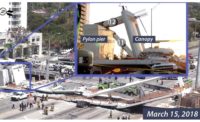After a 15-month probe, the National Transportation Safety Board has determined the probable cause of last year�s fatal I-35W bridge collapse in Minneapolis was a design error that caused the failure of gusset plates on the 41-year-old 1,907-ft-long steel-deck truss bridge. They could not carry loads that included deck upgrades, construction materials, equipment and rush-hour traffic when it fell, killing 13 people and in�juring 145. The eight-lane bridge was a non-redundant fracture-critical structure.
Along with the main finding, which the board approved on Nov. 14, NTSB also blamed the failure of the quality-assurance procedures of bridge designer Sverdrup & Parcel and Associates Inc., St. Louis, to ensure calculations for the gusset plates on the bridge’s main truss were performed, and federal and state transportation agencies’ “inadequate design review.” Sverdrup & Parcel was later acquired by Jacobs Engineering Inc., Pasadena, Calif., which did not respond to ENR’s calls seeking comment.
According to NTSB, another contributing factor was federal and state transportation officials’ “generally accepted practice” of not giving adequate attention to gusset plates during inspections and excluding the plates in load-rating analyses. The board’s full report will be issued in several weeks.
As engineers, contractors and government officials review a summary of the findings, they also are focusing on NTSB’s nine recommendations to the Federal Highway Administration and American Association of State Highway and Transportation Officials. They include paying much closer attention to gusset plates in design and inspections. They also call on FHWA and AASHTO to develop a bridge-design quality-assurance/quality-control program. NTSB also wants AASHTO to revise its bridge- evaluation manual to add guidance for carrying out load ratings on new bridges and develop specifications to ensure that construction materials on a bridge do not overload the structure.
After the NTSB released its findings, U.S. Transportation Secretary Mary Peters ordered FHWA to work with states to improve quality control during bridge design and revise manuals and inspection procedures to include guidance for gusset plates.
“We haven’t been waiting for the report,” says Mal Kerley, Virginia DOT chief engineer and chair of AASHTO’s bridge subcommittee. In May, AASHTO’s highway committee approved $1 million for a study with FHWA on gussets.
“I think what comes out of this is the need to look at the whole process, from design to construction to maintenance of our bridges,” says Tom Warne, a Salt Lake City consultant and former Utah DOT director. “If anything, we’ve learned from I-35W that there were lots of points along the way where failure probably could have been avoided.”
The focus on gusset plates was not a surprise. In a Jan. 15 recommendation, NTSB said that “the original design process led to a serious error in sizing of some of the gusset plates in the main trusses.” The plates at eight of the 12 nodes on the main trusses were 1⁄2 in. thick, “roughly half the thickness required,” it said. The gusset plates were about 72 in. high and 100 in. wide.
NTSB said gusset plates failed at the U (for “upper”) 10 node of the truss. Jim Wildey, chief of NTSB’s materials laboratory, said investigations showed all four plates at node U10 fractured in similar ways. He said investigators determined that conditions such as corrosion and pre-existing cracking on steel members did not contribute to the collapse.




Post a comment to this article
Report Abusive Comment